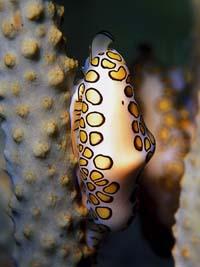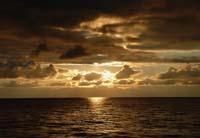Salt sweets of aquatic life

If we make a very simple scheme of living beings, we can say that they are an aqueous solution surrounded by a membrane --body crust -. And to continue living it is necessary to maintain the concentrations of this solution within a narrow range (homeostasis). That is, living beings must maintain their inner environment as stable as possible.
However, on many occasions, the conditions of the outer environment are very different from the inner environment of living beings. Almost all vertebrate animals (fish, amphibians, reptiles, birds and mammals) have the same blood salt concentration: 0.9%. The salt concentration in the sea is 3.5% and that of fresh water does not reach 0.1%. Therefore, in many cases, the living beings we have defined as dissolution live in another solution of very different concentrations.
And between dissolution of different concentration there is always a natural tendency to equal concentrations. For this, on the one hand, solutes tend to move from a more concentrated place to a less concentrated place. It is called diffusion. And on the other hand, osmosis, that is, when there is an intermediate semifiltering membrane that lets the water pass, but not the solute-- the water passes through a small concentration of solutes to a high concentration. Or what is the same, osmosis is the diffusion of water.

We also perceive the effects of osmosis on our skin. If we spend too much time in the shower, for example, fresh water has less salt concentration than us, so the skin absorbs water and we go out with wrinkled fingers. When we bathe in the sea, the skin loses water and then we noticed it dry and tense.
Fight against the environment
Thus, many aquatic animals have a problem to solve with salinity or falsehood. Some, like most marine invertebrates, solve this problem in the simplest way: they present the same saline concentration of the medium in the internal fluids. It is said that these beings are osmoconformists; if the concentration of the medium changes, their body changes in the same way. Therefore, in general, they are not able to withstand changes and must live in stable means (at sea).

However, many other animals are osmoregulators: their concentration of salts in their body is different from that of the outside. As has already been mentioned, practically all marine vertebrates maintain the body in almost a quarter of the environmental saline concentration. That is why they are said to be hypoosmotic. And most freshwater animals are hyperosmotic with the medium, due to their higher concentration of salts than the medium.
Animals living in freshwater tend, therefore, to drink water and to lose salts - by osmosis and diffusion. And they must face this trend to maintain the conditions of the interior environment. The water that enters passively is removed by the excretion system. The kidneys of freshwater fish produce very diluted urine, thus eliminating the excess water. To compensate for the loss of salts, on the one hand, they are obtained from the food and, on the other, they are actively absorbed against the gradient, dissipating energy. This occurs, for example, in the gills of fish and in the vicinity of the operculum, as well as in the skin of amphibians.
At sea, apart from osmocosmonformist invertebrates, vertebrates have a problem against fresh water. They tend to dehydrate and salts penetrate outwardly into the inner environment by diffusion. There are different strategies to address this problem.
Elasmobranchs (sharks, fish...) instead of expelling urea, accumulate it in the fluids of the body. In most vertebrates, this concentration of urea would negatively affect proteins, but elasmobranchs also accumulate trimethylamine oxide, which protects proteins against urea. These compounds achieve the same osmotic concentration as sea water in internal fluids, thus avoiding the loss of water by osmosis. However, inorganic electrolytes are injected by diffusion (Na + and Cl - mainly) that have a special ejection gland in the rectum.

The internal osmotic concentration of other marine fish (telephones) is almost four times lower than that of the sea, so they tend to lose water. Therefore, they produce urine concentrated in the kidneys to reduce the loss of water. However, they continue to lose water -- especially by the gills -- and to fix it they have to drink. They absorb between 70% and 80% of the drinking water and pass to the blood. But the water they drink is, of course, salty, so they must actively eliminate that salt thanks to the work of the kidneys, on the one hand, and from the gills, working against freshwater fish. Finally, thanks to the work of the kidneys and gills, the result is water retention.
Marine reptiles and birds have salt glands such as sharks around the nostrils. These glands produce and expel a concentrated solution of Na + - and Cl. Thanks to these glands, marine reptiles and birds can drink salt water from the sea.
On the contrary, marine mammals lack salt glands or special salt elimination mechanisms. Therefore, they cannot drink sea water, or at least as little as possible. Thus, although they are surrounded by water, they have a problem similar to that of desert animals. To combat it, they have a very effective kidneys and are able to produce very concentrated urine. In addition to obtaining food water, they have a metabolism adapted to benefit from metabolic water (water obtained as the final product of metabolism).
In two waters

Not all aquatic animals have the same ability to adapt to the saline concentration of the medium. Some are stenohalines: tuna and gold fish can only live in a narrow margin of salinity. Other are the haline rains, which can withstand larger salinity stretches, from fresh water to salt water from the sea.
River rains usually live in meeting areas between rivers and seas. In these zones the conditions are very variable. But there are also people going from one to the other. Salmon and lamprea are born in the river and go to the sea to return to the river to reproduce. The eels, on the other hand, do the opposite: they are born in the sea, grow in the river and return to the sea.

Animals that perform this type of migrations must completely change their physiology and behavior to move from one medium to another. For example, when a salmon is in fresh water, it practically does not drink -which enters the meal- and its kidneys produce abundant diluted urine. But as young salmon approaches the sea, it begins to drink, and the kidneys produce less and more concentrated urine. In addition, the mechanism of penetration of the salts of the gills begins to work backwards, extracting the salts that it first introduced.
These changes occur gradually and during those days or weeks young salmon are found in the mouths of rivers, in increasingly salty waters. Once prepared, they dive into the sea, where they remain for several years. Then, when the mature salmon is ready to reproduce, it returns to the mouth of the river where it was born and reverses the changes made when it was young, recovering the capacities of the youth to reclimb the river.






